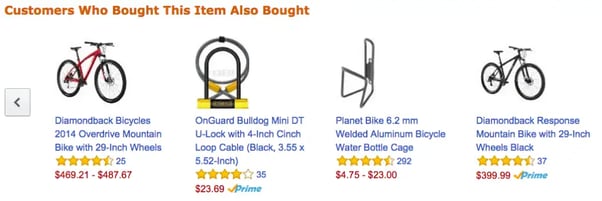Top 14 Post-Purchase Experience Strategies (With Tips & Examples)
Providing an incomparably seamless customer experience is what every eCommerce business dreams of and works toward achieving.
The secret to achieving this starts with realizing that your relationship with your customers does not end when they press “Buy” on your website. On the contrary, this action taken by a customer marks the start of a new phase in their relationship with your business, one where you have to prove to them that you care about their satisfaction as much as you care about your sales. This phase is called “Post Purchase Experience.”
Understanding how post-purchase experience works and how it can affect your eCommerce store is necessary to overcome the harsh competition in the eCommerce sector. Keep reading this article to understand the meaning of a post-purchase experience and learn some of the top strategies that can help you guarantee your customers the best post-purchase experience possible.
Table of content:
- What is Post-Purchase Experience?
- Top 14 Post-Purchase Experience Strategies For E-Commerce:
- Understand Your Customers
- Consider Email Marketing Your Best Friend
- Collect Feedback And Customer Testimonials
- Have A Convenient Return And Exchange Policy
- Offer Personalized Product Recommendations
- Optimize The Order Tracking And Delivery Experience
- Get Creative With The Packaging
- Have An Online Community
- Develop Attractive Referral And Loyalty Programs
- Invest In An Omnichannel Around The Clock Customer Support
- Deliver Compelling “Unboxing” Content
- Deliver Useful Tips On “How To Use” And “Product Care”
- Be Responsible And Accountable
- Always Stay In Touch
What Is Post-Purchase Experience?
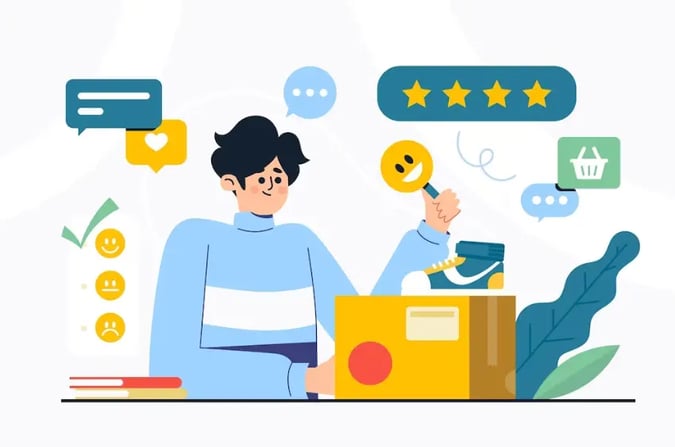 Image source: freepik
Image source: freepik
Post-Purchase experience is defined as all the interactions the customers have with your business after they purchase a specific product from your store or subscribe to a particular service you offer.
Post-purchase experience encompasses all the processes and activities that start right after your customers buy from your store, and it is shaped by how you treat these customers during this phase. It is a critical part of the customer journey because it directly affects your customers’ perceptions, emotions, satisfaction, and subsequent actions toward your brand.
For an eCommerce business, a post-purchase experience is crucial because it is the ultimate way to customer satisfaction; hence, customer retention and everyone knows how important retaining customers is given the constantly skyrocketing customer acquisition costs.
Top 14 Post-Purchase Experience Strategies For E-Commerce
Now that you understand what a post-purchase experience is and what it entails, it is time for you to start learning some top-notch strategies to help you design the perfect post-purchase experience for the customers of your eCommerce store.
1- Understand Your Customers
Understanding your customers is the strategy that comes at the top of all other strategies. Based on the results you’ll get from well studying your customers and all the data you will gather about them, you will be better equipped to decide which post-purchase experience strategies you should adopt.
A post-purchase strategy can be very effective to some customers but irrelevant to others. Hence, you should always invest in segmenting your customers into distinct groups, work on understanding each, and identify a group of strategies for each customer segment.
Speaking of customer segmentation and target audience, Converted.in offers an exceptional marketing automation tool that can easily segment your customers and gather all your customer data into one place like a hub for easy access.
2- Consider Email Marketing Your Best Friend
When it comes to post-purchase experience, email marketing is always there for you. It is one of the most commonly used tools to implement different post-purchase experience strategies.
Post-purchase emails can help you in many ways that we will explore in more detail in the following points. Such emails include:
- Thank you emails
- Order/shipping confirmation emails
- Emails that include surveys and asking for feedback
- Product recommendation emails
- Emails telling about loyalty programs
- Replenishment emails
However, to get the best results, it is better to have an inclusive post-purchase email campaign that includes a series of emails serving all the previously mentioned purposes.
As we all know, all post-purchase emails are sent to customers after they complete a purchase from your eCommerce store. However, when working with a post-purchase email campaign, you should have a detailed schedule indicating the following:
- The type of each email you’re sending,
- its purpose
- and the exact time it will be delivered to customers.
** Check out this article to learn about the top 10 post-purchase email ideas for eCommerce.
Speaking of email marketing, the automation tool we’ve mentioned in the previous point can also create, launch, personalize, and automate all your email marketing campaigns.
3- Collect Feedback And Customer Testimonials
One of the best post-purchase experience strategies is collecting feedback, reviews, and other types of customer testimonials. It is also one of the post-purchase email purposes mentioned in the previous points. In other words, you can implement this strategy through a post-purchase email campaign.
Asking your customers for feedback can greatly improve their customer experience with your eCommerce store for two main reasons:
- It shows customers that you value their opinions regarding your products or services.
- You can use this feedback to improve your eCommerce brand in many ways.
Tips:
- Always consider the type of product or service you are offering before asking your customers for their reviews.
For example, if you are asking for a review about an item of clothing, you can send an email right after the customer receives the order. However, if you are asking for a review about a subscription service to an automation tool, you might need to give your customers a chance to try the tool several times before asking them for the review.
- After gathering testimonials from current customers, make sure to display them on your website and social media accounts so that they would improve the experience of potential customers exploring your brand for the first time.
- You can collect feedback whether through a survey or by asking customers to leave a review on your website.
Example: Macy’s
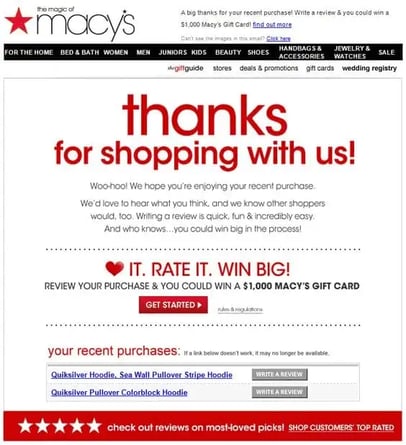
As you can see in the example, Macy’s did not just ask for a review in their email; it also offered an incentive to encourage email recipients to write the review (Review Your Purchase & You Could Win A $1,000 Macy’s Gift Card). That is a smart tactic to collect customer feedback and improve the customer’s post-purchase experience.
4- Have A Convenient Return And Exchange Policy
Another thing that improves a customer’s post-purchase experience is being able to easily return or exchange the product they purchased or the service they subscribed to if they are not satisfied with it.
Therefore, you need to work on professionally handling returns and exchanges. That will help reduce customer anxiety and increase their trust in your eCommerce brand.
Tips:
- Make sure the process of returning or exchanging an item from your online store is not too complicated.
- Allow refunds in your return policy because it makes customers feel safe knowing that they can get their money back.
Example: American Eagle
 Image source: invespcro.com
Image source: invespcro.com
In this example, we can see how American Eagle works on improving their post-purchase experience by implementing a convenient return and exchange policy. They offer a full refund without a time limit if the customer has the receipt. They even consider customers who might have lost their receipts by offering them the chance to exchange the item or get store credit.
5- Offer Personalized Product Recommendations
Offering product recommendations is another post-purchase experience strategy that will not only enhance your customers’ shopping experience but can also boost the sales of your eCommerce store.
Tips:
- Implementing personalization is a must when dealing with product recommendations because there is no point in recommending products irrelevant to the customers’ preferences or buying behavior.
- You can always incorporate this strategy in your post-purchase email campaign. However, you can also implement it on your website right after the customer completes a purchase. You can do this through upselling and cross-selling right after checkout.
Example: Amazon
Amazon is always a great example when discussing product recommendations, upselling, and cross-selling. It perfectly leverages these strategies to optimize its customers’ post-purchase experience, which gives it a competitive advantage in the eCommerce sector.
6- Optimize The Order Tracking And Delivery Experience
A great post-purchase experience isn’t complete if you don’t communicate with your customers about the status of their orders. Notifying customers when their order is shipped is not enough anymore. Today, customers want to track every step of the process, from the moment their purchased items leave the warehouse to the one it reaches their door.
Tips:
- Personalization is not only used with product recommendations. You can personalize the delivery experience of your customers as well. You can do this by offering each customer or group of customers a delivery option that suits their preferences and behaviors.
- Add an order-tracking feature to your website or mobile app to provide customers with the real-time status of their orders.
Example: Peter Hahn
![]() Image source: parcellab.com
Image source: parcellab.com
In this example, Peter Hahn provides customers with all the details they might want to see about their order after completing the purchase. The store shows everything with the exact date and time. For example, the store shows when the order arrives in the distribution house, when it is on its way, and when it should arrive.
There is also a button labeled “Read More” for customers who still want to know further detail about the status of their order.
We can also notice the flexibility in the delivery in this question added right below the delivery date: “Not going to be in? Rearrange delivery.”
7- Get Creative With The Packaging
Packaging is the first thing your customers see when they receive their order from you; hence, it directly affects their first impression. That’s why you should put effort into your packaging.
Research shows that 50% of customers will recommend your product if it comes in gift-like or branded packaging (Dotcom Distribution, 2022), and customers recommending your products to their friends and family is a sign of them having a great post-purchase experience.
Tips:
- Your packaging should grab the customers’ attention and reflect the values of your eCommerce brand.
- Recyclable packaging is gaining more popularity, especially with customers who care about the environment.
- Add manuals and product descriptions with your package to help guide your customers.
- Include free personalized product samples or discount codes to encourage customers to make another purchase from your store.
Example: Ohh Deer
 Image source: gorgias.com
Image source: gorgias.com
The stationary store Ohh Deer offers a great post-purchase experience to its customers through its exceptional packaging. As we can see in the previous image, the packaging is colorful and eye-catching. It is also recyclable, which makes it even more attractive to many customers.
8- Have An Online Community
Online communities are becoming a significant part of customers’ post-purchase experience. Building an online community for your eCommerce brand will not only positively impact the post-purchase experience of your customers, but it can also help you create long-term relationships with them and enhance customer retention.
Online communities allow your customers to interact with your brand and other customers with whom they can share their experiences.
Tips:
- Offer incentives for your customers to encourage them to join the online community of your eCommerce brand.
- Deliver attractive content and drive conversations within the community.
Example: Glossier
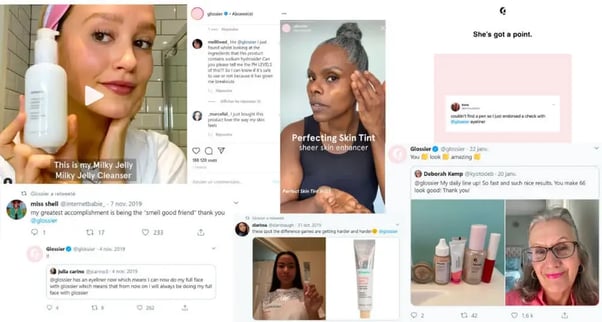 Image source: tokywoky
Image source: tokywoky
Glossier is a perfect example of a community-driven beauty brand. The bio of their Instagram profile says: “ Glossier Inc. is a people-powered beauty ecosystem.”
Glossier excels at leveraging its online community to create an incomparable post-purchase experience. Through its online community, the brand co-creates products with customers, turns loyal customers into brand representatives, and even features customers in national ads.
9- Develop Attractive Referral And Loyalty Programs
Referral and loyalty programs are also part of the post-purchase experience of any successful eCommerce business. In addition to the benefits they offer for your customers, they help you optimize customer retention and reduce customer acquisition costs.
Tips:
- Do your best to convince your customers that the value of joining your referral and loyalty programs outweigh the costs.
- Make your programs easy to understand and accessible to any customer willing to join.
Example On Referral Program: Athleta
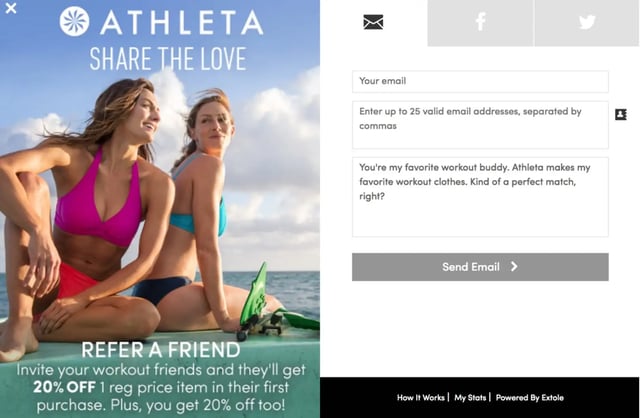
Example On Loyalty Program: Shein
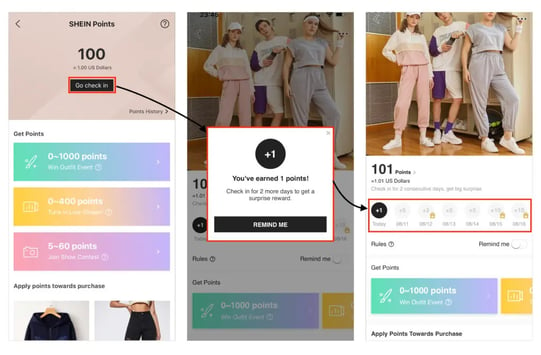
The common thing between the two examples is that they are both using incentives to attract customers. Also, both brands are succeeding at making the value of joining the referral or loyalty program worth the effort or costs.
** Check out these two articles to learn more about how to create the best eCommerce loyalty program, and how to create a successful referral program for an online store.
10- Invest In An Omnichannel Around The Clock Customer Support
Post-purchase customer support is essential for customers to have a good experience with your online shop. However, you don’t want to provide any kind of customer support. You want to provide one that does help your customers in every possible way.
For that to happen, your customer support should be omnichannel. To better illustrate, having an omnichannel approach means offering your products and services, including the service of customer support, to customers across all channels, platforms, and devices available. That means you should provide real-time customer support wherever your customers are and whenever they need it.
Tips:
- Make sure the quality of customer support you offer is consistent across all channels.
- Remember that having omnichannel customer support means placing your customer at the center of your communication strategy. To succeed in implementing that, you need to be aware of how to adopt a customer-centric approach for your eCommerce store.
- Have a team ready to answer messages, emails, and phone calls from customers around the clock. However, since we are living in 2023, you can automate this entire process. There are AI-powered chatbots today, such as ChatGPT, that can do that for you.
Example: Zappos
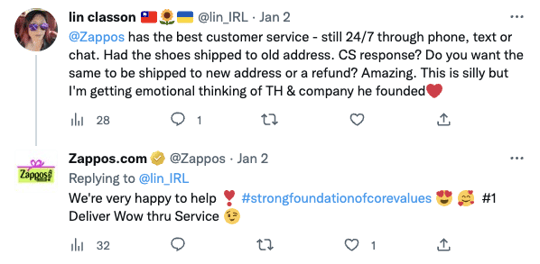
Zappos is one of those eCommerce stores succeeding in offering an exceptional post-purchase experience to customers with their omnichannel customer support. The brand offers customer support across different channels, such as Twitter, texts, and a 24/7 call center. However, what’s even more noticeable is that across all these channels, custom support agents are all equipped with enough information to solve any kind of problem that customers might have.
11- Deliver Compelling “Unboxing” Content
If your eCommerce store sells the kinds of products you can leverage to create unboxing content, we advise you to do it. Delivering unboxing content not only enhances the pots-purchase experience of your customers but also works as a great way to market your brand, products, or services.
Tips:
- Make sure your unboxing videos are not boring.
- If you don’t want to create unboxing videos yourself, persuade your customers to do it. For instance, you can launch contests where customers have to share their own unboxing videos while tagging your brand. User-generated content makes the post-purchase experience fun for customers are allows your brand to reach a wider audience.
Example: Palladio Beauty

Palladio Beauty is a brand that leverages all the user-generated unboxing videos and makeup tutorials by always resharing this content on its Instagram page.
12- Deliver Useful Tips On “How To Use” And “Product Care”
Additional to unboxing content, content that shows customers how exactly to use the product and take care of it is one more thing that optimizes the post-purchase experience. This strategy aims to try and solve the customers’ problems without them reaching out to your customer support.
Tips:
- You can include this information in your package when delivered to the customer, on your website, or blog. You can also send them to your customers via email.
Example: Charles & Keith

Charles & Keith dedicates a page on its website to give customers tips about how to take care of their products after purchasing them. That is very helpful because it is categorized based on the material of each product; hence, it serves all the brand’s customers.
13- Be Responsible And Accountable
Another secret to giving your customers the best post-purchase experience possible is to be a responsible and accountable brand. That means that if you make a mistake, such as delivering a wrong product, you should be willing to acknowledge your mistake, apologize to your customers, and do everything in your power to fix the situation.
Remember, there is nothing wrong with making mistakes. The important thing is not to run away from it.
14- Always Stay In Touch
Even after implementing all the previously discussed strategies, you shouldn’t stop communicating with your customers. As mentioned before, offering your customers a great post-purchase experience should help enhance customer retention. However, this will not happen if you do not stay in touch with your customers.
Remember that staying in touch with your customers will keep them coming back to you.
Final Thoughts:
To sum up, this article proved that the customer journey doesn’t end when the customer takes action and that your relationship with your customers extends far beyond the moment of purchase. As someone in the eCommerce business, you should always consider the significance of post-purchase experience strategies for your store.
 By
By
